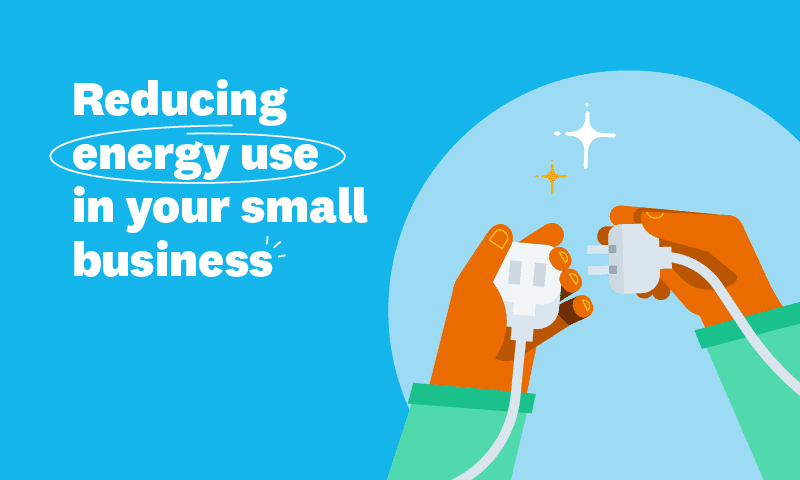

For sustainability-minded small business owners, looking at your energy use is a powerful way to continue your environmental journey.
Whether your employees share an office or warehouse, your vehicles are electric or petrol, in order for your business to operate every day, some form of energy needs to power it.
Reducing your energy use doesn’t mean stopping all these things completely. Instead, it’s about considering how you can make your energy use cleaner and more efficient.
Maximising energy use in your buildings
If your business has an office, warehouse, shop or any other kind of building facility, this should be your first area to tackle. There are plenty of things to investigate, including:
- Building design – such as lighting, insulation and heating or cooling
- IT equipment – including laptops, servers and TV screens
- Employee facilities – such as kitchen fridges, coffee machines and other white goods
Start with things you can do today, including making better use of natural light, switching to energy efficient light bulbs and talking to your employees about turning off lights and equipment when they’re not using it. You can also look at the energy suppliers available in your area to see if you can find one that uses more climate friendly energy resources. Check out case studies online for inspiration and examples of how other small businesses have reduced energy use.
In the short to medium term, start paying attention to the energy rating on new IT equipment and any kitchen appliances you need to replace. If there are areas that aren’t always in use, such as lunch rooms, kitchens, and bathrooms, occupancy sensors are a good idea.
You can also consider getting a professional company to come in and do an energy audit so you know what to address going forward. These audits vary in scale, and you can pick the type of audit that makes sense for your business.
Bigger projects might include modifying your insulation, ventilation and heating and cooling systems, which can result in big energy savings. If you own the property, solar power might be an option. Centrally controlled smart thermostats regulate and adjust the temperature automatically so you can avoid staff in one part of the building switching on heating, while others crank up the air conditioning.
If you’re located in a hot country, think about ways to shade your building with trees and bushes, or something that covers the sun-facing windows. If you’re located in a cold country, insulation, double glazing and draught exclusion can make all the difference. Again, you can ask a professional company to come and advise you on this, in some cases there are government grants available to help fund this work
Reducing the environmental impact of your company vehicles and going remote where you can
Switching to virtual or online meetings where possible can have a significant positive impact on the environmental footprint of your business. Most passenger cars produce around 650g of carbon dioxide per kilometre, that’s just over 1kg per mile, so swapping the car trip for a phone or video call can help a lot.
Virtual meetings enable the sharing of ideas among much wider audiences, as travel is no longer a factor in determining their participation and contribution. They are low-carbon, particularly when compared to driving, or even flying. Another added benefit is how much more affordable they can be for the company. The costs of face-to-face meetings quickly add up when you consider the travel, arranging venues, and the time required.
Another area to consider is optimising any travel that must be completed as part of running your business. When your employees need to drive to different locations, or if delivery is a key part of your service, the use of vehicles can make a big difference to your environmental impact. There are a handful of apps available in the Xero App Store that can help you optimise shipping routes for transport businesses, and group jobs geographically for travelling tradespeople.
Lastly when it comes to vehicle selection, the future is bright for hybrid, or even fully electric vehicles.
Considering energy use in your supply chains
It’s likely that your business involves more than just the people you employ and the buildings you occupy. You probably have suppliers, and they too can help you reduce your energy footprint.
- Audit your suppliers: Find out if your suppliers are taking steps to improve their energy use.
- Go local: When your suppliers are close by and you’re using local resources, there’s less energy involved in getting their products to you.
- Reduce and reuse: Think about what in your business you can live without having as brand new. This can be a tricky one to weigh up, because newer electrical appliances are often more energy efficient than older models. However, if you need office furniture or warehouse shelving, you might be able to reuse what another company used previously. You could look into whether there’s a local company you can rent it from, or purchase second hand.
Want more information about being an environmentally friendly small business?
Check out our Small Business Sustainability Education Hub featuring resources from Xero, Cogo, ACCA, United Nations, and others. It’s designed specifically to help small businesses reduce their environmental impact, for more support on your journey towards a greener business model.





